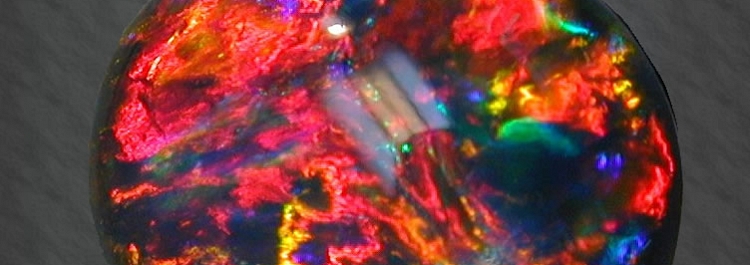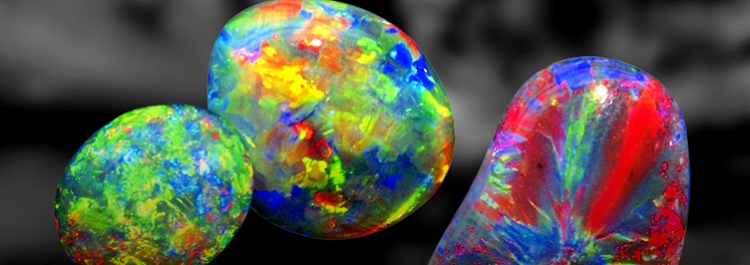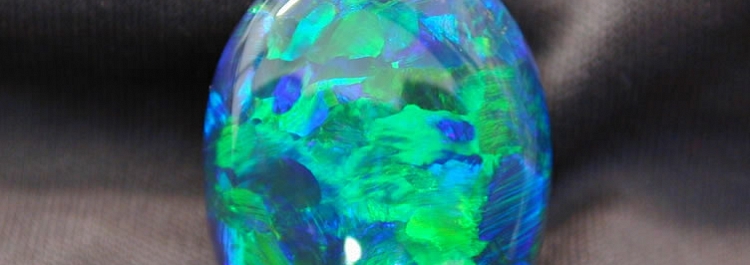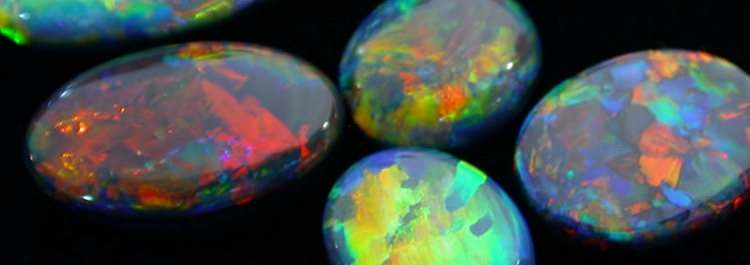Precious opal is composed of minute uniform spheres of silica, which are arranged together in an orderly three-dimensional grid. The spaces between these spheres contain silica in solution. However, in common opal, where there is no play of colour, the spheres are of varying sizes and are not uniformly stacked.
White light passes through the transparent spheres directly, but when it reaches the silica in solution, it is deflected at angles. These diffracted beams of light may show all the colours of the spectrum, or particular colours may predominate.
The colour emitted from the opal is dependent on the size of the spheres, which determine the wavelengths .For instance, blue colours are evident where the spheres are smaller and, at the other end of the spectrum, orange and red will be evident where the spheres are larger. The intensity and brilliance of the colours are a result of the degree of uniformity of size and regularity of the grid.
The value of an opal is determined by the type of opal, the predominant colours it exhibits, the clarity or brilliance of these colours, and the patterns in which the colours are arrayed. Good patterns of diffracted colours have an enormous impact on the value of the opal. Pinfire and small type patterns are more common, and thus less expensive than broad patterns or large flashes. Distinct patterns such as rolling flash, straw pattern, Chinese writing, ribbon, and especially harlequin, are very rare and considered collectors' items.
Valuing opal
There is no governing body which has set the prices for opal; they are the result of what the international market is prepared to pay in order to obtain the gem. As with any other commodity, opal is subject to the laws of supply and demand. The supply of opal is never guaranteed - the luck of the miner, variable costs, new discoveries, floods and weather conditions - all affect the supply of the stone. Demand relates to the enthusiasm of the customer for opal, and may be influenced by the world economy, fashion and market trends.
The value of an opal will depend upon a number of factors, some of which we have outlined here:
Brilliance – The degree of brightness is of paramount importance. An opal cannot be valuable without this attribute. A gem that glows but is average in other respects can command a high price, whereas a dull stone, with a very good pattern and range of colours may bring only an average price.
Body Tone – The base tones of light, dark and black opal range from colourless, white, through the various shades of grey, to black.
Transparency – Opal of any body colour will be opaque, translucent or transparent. When it is transparent or very translucent, and the colour clarity is sharp, it is often referred to as crystal opal.
Pattern – Interesting patterns of the diffracted colours are rare and when combined with brilliance, have an enormous impact on the value. Pinfire and small type patterns are less desirable than broad patterns or large flashes. Distinct patterns, such as rolling flash, straw pattern, Chinese writing, ribbon and harlequin are highly sought after.
Dominant Diffracted Colours – Great care needs to be taken when applying this factor, remembering that type and brilliance override all other factors. A blue-green brilliant stone will usually be more valuable than a dull red stone. The dominant colour has value in this order: red, orange, yellow, green, blue, indigo, and violet. The red and orange colours are the more valued. This rule is more particular to black opals. Strong red colour plays in a dark body toned black opal is the most valuable.
Thickness of the Colour Bar – Black opals and black boulder opals with a very thin colour bar are frequently worth many thousands of dollars per carat although they would be worth more if they had exactly the same appearance with a thicker colour bar. Thickness of the bar enables a domed surface to be out from the rough, thereby increasing value.
Shapes – Precious opal is usually cut into oval, pear, or round shapes. Occasionally, other shapes are cut including marquis, rectangle and heart. Non-standard shapes include freeform and baroque. Shapes which will produce difficulty for the jewellery setter will often decrease the value of the stone.








